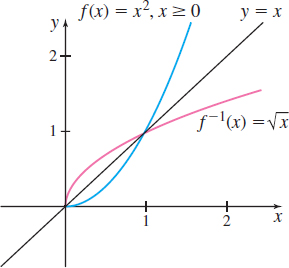EXAMPLE 6Finding the Inverse of a Domain-Restricted Function
Find the inverse of f(x)=x2 if x≥0.
Solution The function f(x)=x2 is not one-to-one (see Example 1(a)). However, by restricting the domain of f to x≥0, the new function f is one-to-one, so f−1 exists. To find f−1, follow the steps.
Step 1 y=x2, where x≥0. Step 2 Interchange the variables x and y: x=y2, where y≥0. This is the inverse function written implicitly. Step 3 Solve for y: y=√x=f−1(x). (Since y≥0, only the principal square root is obtained.) Step 4 Check that f−1(x)=√x is the inverse function of f. f−1(f(x)) =√f(x)=√x2=|x|=x,where x≥0f(f−1(x)) =[f−1(x)]2=[√x]2=x,where x≥0
